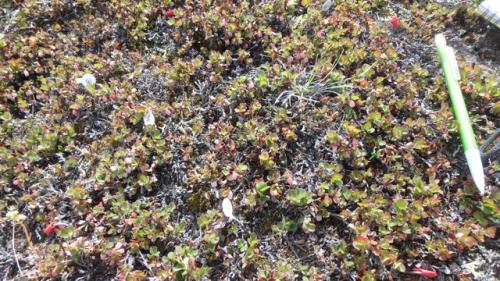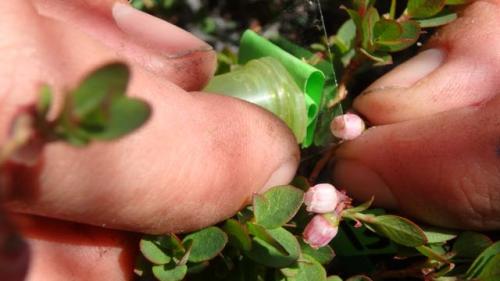Blueberry Plants
Our main activity this week involves the plant-pollinator experiment for which our research is named. Christine's focus plant is Vaccinium uliginosum, the blueberry plant that I showed in an earlier journal; I'll put it in here too.
 These tiny blueberries will be ripe in August.
These tiny blueberries will be ripe in August.
The leaves are typically about 1cm long and the flowers about 3mm. The berries are a little bigger than that when they're ripe and apparently taste just like blueberries at home, ranging from tart to very sweet. Some Greenlanders say they taste best when picked right after a rain. They won't be ripe until August, so I won't get a chance to taste them.
 The flowers on the blueberry plant are about the size of 1/4 of my pinking fingernail!
The flowers on the blueberry plant are about the size of 1/4 of my pinking fingernail!
The Research
Christine's project involves 15 warm research sites farther from the ice sheet (20-24 miles) and 15 close to the ice. The conditions are different in these two sets of places in a number of ways. At the sites distant from the ice the air is warmer (3 Celsius or about 6 Fahrenheit), there is less wind, and there is more thawed soil above the permafrost (permanently frozen subsoil).
 The plants are very low to the ground in this .25 square meter plot.
The plants are very low to the ground in this .25 square meter plot.
Observations
We are finding that the plants more distant from the glacier have earlier flowers and that therefore, the berries are forming sooner. Next fall in the lab, Christine's research assistants will count the seeds in each blueberry to see whether the fruit from the two conditions differs.
Since Greenland is expected to warm 3 degrees Celsius in the next 70 years, we can probably expect to see this behavior in the more distant sites in the future, that is, the ones that are near the ice now. As the island warms, of course, more land will lose its ice cover, and those areas may be expected to develop in a similar pattern.
 Buds, flowers, and berries are counted at each site.
Buds, flowers, and berries are counted at each site.
Pollination
Another part of Christine's research is to determine which pollinators visit her test plants, how often, and whether or not they are effective pollinators. The job of a pollinator is to transfer pollen from one plant to another to fertilize the seeds. One of our jobs is to hand-pollinate 15 plants (half of them) at each and every site. The idea is to determine whether the plants are highly dependent on the pollinators or not. Hand-pollinating these very small plants is a challenging activity. First, pollen is collected. Christine does this by rubbing a coverslip (a fine piece of one-inch square glass used to cover microscope specimens) on the stamen of a flower. That is the tall reproductive part of a flower. Then this pollen is rubbed gently on the stamen of another flower. Fifteen other flowers are the controls at each site and are untreated. It is small, tedious work and takes time.
 Hand-pollinating tiny blueberry blossoms is careful work!
Hand-pollinating tiny blueberry blossoms is careful work!
Another of our jobs is to count the pollinators that visit each site; we observe for 20-minute periods. Christine also sets up time-lapse cameras for 72 hours at each site. We carefully document each flower that is treated in each site (all 15), pollinator visits, and weather conditions.
 Each and every step or count is documented.
Each and every step or count is documented.
All of these tests are intended to give us a good picture of how these plants succeed in this harsh environment.
Flag of the Day
 Daniel's whale and iceberg flag.
Daniel's whale and iceberg flag.

Comments